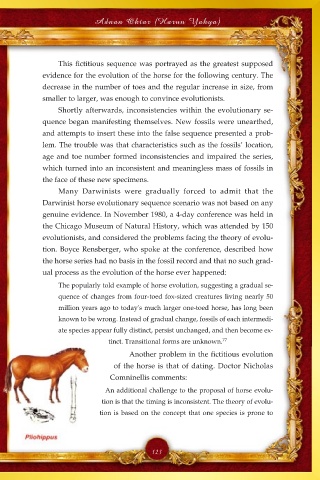Page 125 - Death of the Darwinist Dajjal System
P. 125
Adnan Oktar (Harun Yahya)
This fictitious sequence was portrayed as the greatest supposed
evidence for the evolution of the horse for the following century. The
decrease in the number of toes and the regular increase in size, from
smaller to larger, was enough to convince evolutionists.
Shortly afterwards, inconsistencies within the evolutionary se-
quence began manifesting themselves. New fossils were unearthed,
and attempts to insert these into the false sequence presented a prob-
lem. The trouble was that characteristics such as the fossils’ location,
age and toe number formed inconsistencies and impaired the series,
which turned into an inconsistent and meaningless mass of fossils in
the face of these new specimens.
Many Darwinists were gradually forced to admit that the
Darwinist horse evolutionary sequence scenario was not based on any
genuine evidence. In November 1980, a 4-day conference was held in
the Chicago Museum of Natural History, which was attended by 150
evolutionists, and considered the problems facing the theory of evolu-
tion. Boyce Rensberger, who spoke at the conference, described how
the horse series had no basis in the fossil record and that no such grad-
ual process as the evolution of the horse ever happened:
The popularly told example of horse evolution, suggesting a gradual se-
quence of changes from four-toed fox-sized creatures living nearly 50
million years ago to today's much larger one-toed horse, has long been
known to be wrong. Instead of gradual change, fossils of each intermedi-
ate species appear fully distinct, persist unchanged, and then become ex-
tinct. Transitional forms are unknown. 77
Another problem in the fictitious evolution
of the horse is that of dating. Doctor Nicholas
Comninellis comments:
An additional challenge to the proposal of horse evolu-
tion is that the timing is inconsistent. The theory of evolu-
tion is based on the concept that one species is prone to
123

